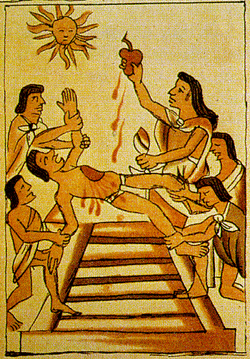
Mayan Human Sacrifice
The Mayans (from circa 1800 BC) were chronologically the first of the Pre-Columbian Empires, preceding the Aztecs (from circa 1248 AD) who appeared about 3000 years later.
Both Mayans and Aztecs settled in Mesoamerica, which is the vast region that comprises present-day Mexico and Central America.
While Aztecs lived in modern-day central and southern Mexico, Mayans lived in the jungles of today’s southern Mexico, Belize, and Guatemala.
There are no doubts that the Mayans practised human sacrifice.
Contrary to what was previously thought of the Mayan Empire and Mayan people, they were not peaceful, and engaged in massacres, wars, human sacrifices. Enemy warriors were taken captive and ordinarily enslaved or sacrificed. High-hierarchy captives like kings and nobles were forced to play in a ritual ball-game against their captors which was a re-enactment of their lost battle, and after the game they were sacrificed.
Sometimes, human sacrifice by Mayans took place after the victim was tortured, whether beaten, scalped, or burnt.
Mayan methods of human sacrifice included what we already know from the Aztecs: cutting out the victims’ hearts.
Other Maya methods were disemboweling, beheading, ritual bloodletting, killing with bow and arrows.
Like the Aztecs human sacrifices, so their Mayan counterparts only stopped thanks to the Spanish Conquistadors who put an end to them. Not always the strongest are worse, sometimes they are better, much better.
Children were often sacrificed.
In 2005 a mass grave of 1-to-2-year-old sacrificed children was found in the Maya region of Comalcalco, probably for consecration when building temples.
Maya priests in the Yucatan peninsula, in the city of Chichen Itza, sacrificed children by throwing them into sacred sinkhole caves, known as “cenotes.”
University of Yucatan archeologist Guillermo de Anda studied the bones of 127 bodies discovered at the bottom of one of those caves and found that more than 80% were probably boys aged from 3 to 11; the rest were men.
De Anda said children were often thrown alive to their watery graves to satisfy the Mayan rain god Chaac, and some of them were ritually skinned or dismembered before being offered to the gods.
Other details of Mayan human sacrifice from Wikipedia:
Some other sacrifice related practices include burning victims alive, dancing in the skin of a skinned victim, taking head trophies, cannibalism, drinking a deceased relative’s bath water, and sprinkling sacrificial blood around sanctuaries.
Like the Aztecs, Mayans also performed human sacrifice of Spanish people. On one occasion Mayans sacrificed Spanish survivors of a ship wreck off the Jamaican Coast. As was often the case, human sacrifice by these savage populations was followed by cannibalism, and some Spaniards’ flesh was served at a feast while others were fattened for later killing.
Mayans were so barbaric that they didn’t just sacrifice Spanish soldiers, unjustifiable as well of course, but even Spanish friars and missionaries, cutting open their chest and excising their heart. The sacrificial victims were then decapitated and their heads displayed on stakes.
Franciscan and Dominican friars were bound in the form of crosses before having their hearts cut out.
PHOTO CREDITS
Mayan Pyramid, Mexico, by PxHere
Mayan human sacrifice, by Scholablogs


